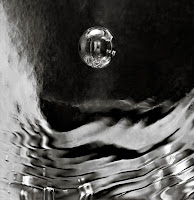 "The physical object, to me, is merely a stepping stone to an inner world where the object with the help of the subconscious drives and focuses perceptions, becomes transmuted into a symbol whose life is beyond the life of the objects we know." - Clarence J. Laughlin, Photographer (1905 - 1985)
"The physical object, to me, is merely a stepping stone to an inner world where the object with the help of the subconscious drives and focuses perceptions, becomes transmuted into a symbol whose life is beyond the life of the objects we know." - Clarence J. Laughlin, Photographer (1905 - 1985)For all those who've expressed, privately and publically, an interest in seeing some of my images in print - apart from my contest-winning Sudden Stillness book, to be published in short order by Envisage Press - I offer the following. A self-published collection of photos, entitled Landscapes of the Soul: Reflected Shadows of Self.
The book consists of four visual landscapes: Water Flow, Entropic Melodies, Spirit & Light, and Micro Worlds. Each offers an interpretation of spirit made manifest, and is introduced by a short essay. There are a total of 120 pages, 52 duotoned images, four essays and a short introduction.
Water flow shows glimpses of dynamic processes at work; though the processes themselves understandably remain hidden.
 Entropic Melodies hints at the boundary between life and death. (A few images from this series appeared in a portfolio in issue #41 of Black and White Magazine.)
Entropic Melodies hints at the boundary between life and death. (A few images from this series appeared in a portfolio in issue #41 of Black and White Magazine.) Spirit & light reveals the physical magnificence and splendor of sacred spaces, as created by human hands, though the spiritual object of devotion lies only in the heart of the observer. (Some of these images were featured in Lenswork Extended Edition #71 (July-August 2007)
Spirit & light reveals the physical magnificence and splendor of sacred spaces, as created by human hands, though the spiritual object of devotion lies only in the heart of the observer. (Some of these images were featured in Lenswork Extended Edition #71 (July-August 2007) Micro Worlds shows the extraordinary resplendent beauty that may be found even in abject banality, but only if the self recognizes that it is its own landscape of the soul. (These are taken from a growing series I'm still working on, and have previosuly featured in an on-line gallery.)
Micro Worlds shows the extraordinary resplendent beauty that may be found even in abject banality, but only if the self recognizes that it is its own landscape of the soul. (These are taken from a growing series I'm still working on, and have previosuly featured in an on-line gallery.)
"To the vast majority of people a photograph is an image of something within their direct experience: a more-or-less factual reality. It is difficult for them to realize that the photograph can be the source of the experience, as well as the reflection of spiritual awareness of the world and of self." - Ansel Adams, Photographer (1902 - 1984)
My original intention for this project (when I started a few weeks ago) was to merely find an "easy" way to archive some of my work; for my own records. Indeed, I honestly wasn't expecting much by way of quality, although I grew increasingly intrigued by seeing references to the "quality of Blurb Books" on various forums and chat groups. Having my "test case" book in hand from this on-line publisher, I can now attest to its overall quality. Very impressive, actually.
Compared to the often less-than-stellar quality of books one sees even on the shelves at Borders, I have no qualms about offering the book for sale. While certainly not as good as fine-art prints (even the best books typically fall far short of that Holy Grail of course), nor even as good as the finest pigment-based ink jets I can produce for exhibits, the images in this volume stand on their own as beautiful book-form reproductions. Of course, the subject matter may not be to everyone's taste, nor the images themselves, but about that I have far less control;-)
For those who find my aesthetics pleasing, I am sure you would find this little collection of some of my recent images very enjoyable.
My original intention for this project (when I started a few weeks ago) was to merely find an "easy" way to archive some of my work; for my own records. Indeed, I honestly wasn't expecting much by way of quality, although I grew increasingly intrigued by seeing references to the "quality of Blurb Books" on various forums and chat groups. Having my "test case" book in hand from this on-line publisher, I can now attest to its overall quality. Very impressive, actually.
Compared to the often less-than-stellar quality of books one sees even on the shelves at Borders, I have no qualms about offering the book for sale. While certainly not as good as fine-art prints (even the best books typically fall far short of that Holy Grail of course), nor even as good as the finest pigment-based ink jets I can produce for exhibits, the images in this volume stand on their own as beautiful book-form reproductions. Of course, the subject matter may not be to everyone's taste, nor the images themselves, but about that I have far less control;-)
For those who find my aesthetics pleasing, I am sure you would find this little collection of some of my recent images very enjoyable.






















